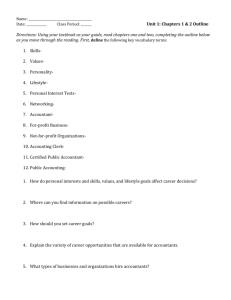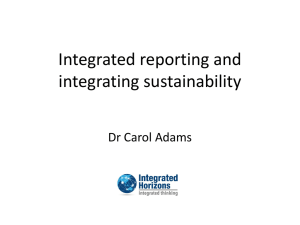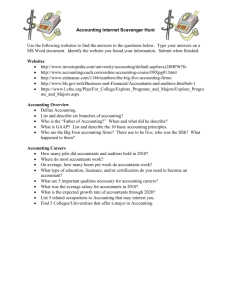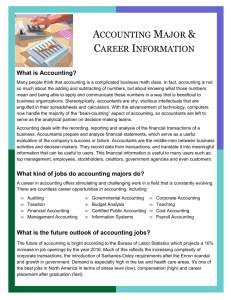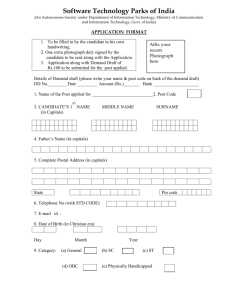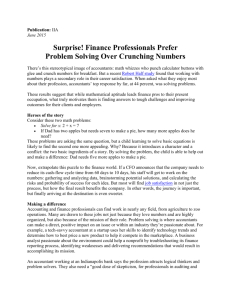Normal Template
advertisement
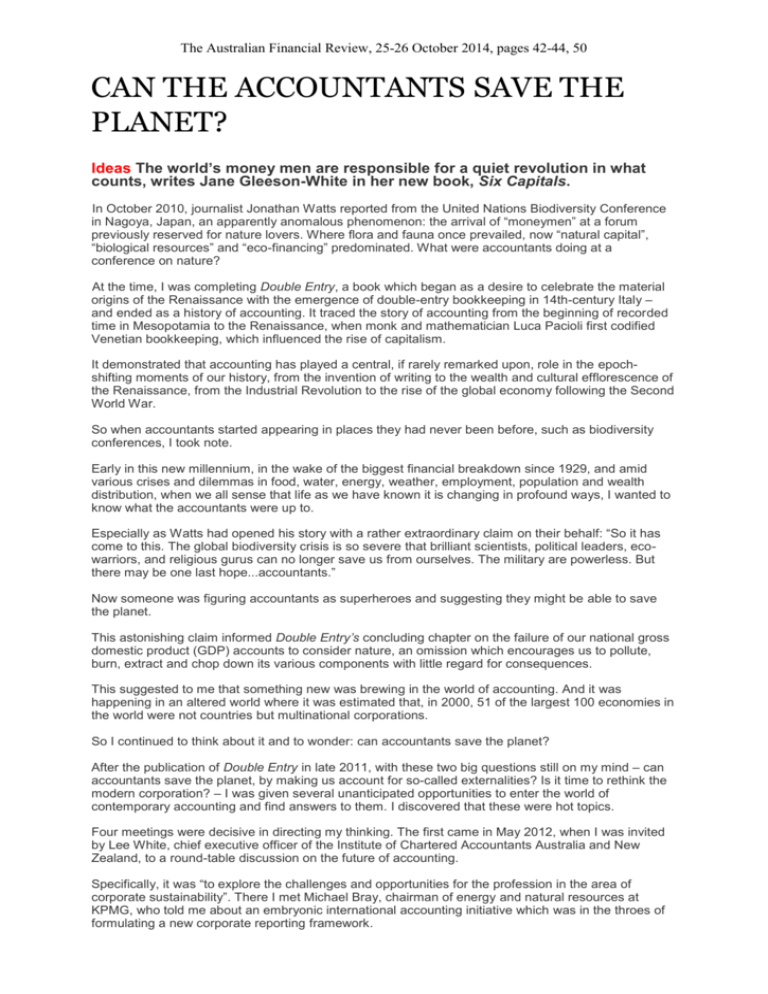
The Australian Financial Review, 25-26 October 2014, pages 42-44, 50 CAN THE ACCOUNTANTS SAVE THE PLANET? Ideas The world’s money men are responsible for a quiet revolution in what counts, writes Jane Gleeson-White in her new book, Six Capitals. In October 2010, journalist Jonathan Watts reported from the United Nations Biodiversity Conference in Nagoya, Japan, an apparently anomalous phenomenon: the arrival of “moneymen” at a forum previously reserved for nature lovers. Where flora and fauna once prevailed, now “natural capital”, “biological resources” and “eco-financing” predominated. What were accountants doing at a conference on nature? At the time, I was completing Double Entry, a book which began as a desire to celebrate the material origins of the Renaissance with the emergence of double-entry bookkeeping in 14th-century Italy – and ended as a history of accounting. It traced the story of accounting from the beginning of recorded time in Mesopotamia to the Renaissance, when monk and mathematician Luca Pacioli first codified Venetian bookkeeping, which influenced the rise of capitalism. It demonstrated that accounting has played a central, if rarely remarked upon, role in the epochshifting moments of our history, from the invention of writing to the wealth and cultural efflorescence of the Renaissance, from the Industrial Revolution to the rise of the global economy following the Second World War. So when accountants started appearing in places they had never been before, such as biodiversity conferences, I took note. Early in this new millennium, in the wake of the biggest financial breakdown since 1929, and amid various crises and dilemmas in food, water, energy, weather, employment, population and wealth distribution, when we all sense that life as we have known it is changing in profound ways, I wanted to know what the accountants were up to. Especially as Watts had opened his story with a rather extraordinary claim on their behalf: “So it has come to this. The global biodiversity crisis is so severe that brilliant scientists, political leaders, ecowarriors, and religious gurus can no longer save us from ourselves. The military are powerless. But there may be one last hope...accountants.” Now someone was figuring accountants as superheroes and suggesting they might be able to save the planet. This astonishing claim informed Double Entry’s concluding chapter on the failure of our national gross domestic product (GDP) accounts to consider nature, an omission which encourages us to pollute, burn, extract and chop down its various components with little regard for consequences. This suggested to me that something new was brewing in the world of accounting. And it was happening in an altered world where it was estimated that, in 2000, 51 of the largest 100 economies in the world were not countries but multinational corporations. So I continued to think about it and to wonder: can accountants save the planet? After the publication of Double Entry in late 2011, with these two big questions still on my mind – can accountants save the planet, by making us account for so-called externalities? Is it time to rethink the modern corporation? – I was given several unanticipated opportunities to enter the world of contemporary accounting and find answers to them. I discovered that these were hot topics. Four meetings were decisive in directing my thinking. The first came in May 2012, when I was invited by Lee White, chief executive officer of the Institute of Chartered Accountants Australia and New Zealand, to a round-table discussion on the future of accounting. Specifically, it was “to explore the challenges and opportunities for the profession in the area of corporate sustainability”. There I met Michael Bray, chairman of energy and natural resources at KPMG, who told me about an embryonic international accounting initiative which was in the throes of formulating a new corporate reporting framework. The proposed system encompasses six capitals, adding to corporate reporting’s traditional focus on financial and manufactured capital four new categories of wealth, including “natural capital”. Bray also mentioned an article written in 1992 by accountant Robert K. Elliott of KPMG New York which argued that our accounting systems are breaking down because they were designed for the industrial era and cannot cope with the new intangible wealth of our information age. The new accounting initiative and the possibilities opened up by Elliott’s argument seized my imagination. I was particularly intrigued by the concept of “six capitals”: financial, manufactured, intellectual, human, social and relationship, and natural capital. At that round-table meeting, I realised that the changes I had felt simmering in 2010 were now cooking at lightning speed. The second meeting was in London in September 2012, with accountant Jeremy Osborn, who had worked with the Prince of Wales’ Accounting for Sustainability project. In my travels I had taken every opportunity to ask accountants: do you think companies will ever put a money value on the environment? Osborn was the first to have a substantial answer to that question. He told me it had just happened. The German sporting goods company Puma had just priced its impact on nature in the world’s first ever “environmental profit and loss account”. This account was Puma’s pioneering attempt to consider the full impact on nature of its activities, from head office right down its supply chain to the providers of rubber for its running shoes. In order to do this, it put a monetary value on the environmental costs of doing business, such as air pollution and waste. Although Osborn had added that he personally did not think it necessary to put a price on nature in order to account for and protect it, the man to whom I next put this question, in London in April 2013, was a passionate advocate for calculating the monetary value of nature for its protection. Leading environmentalist Tony Juniper argued his case in his well-received 2013 book What Has Nature Ever Done for Us? The book gives compelling examples not only of the economic value of the various unpriced components of the natural world, such as soil, bees and mangroves, but also of the persuasive effect – in nature’s favour – of pricing them. The last meeting was in New York in May 2013 when I was invited by accountant Stanley Goldstein to join the New York Hedge Fund Round Table discussion on corporate social responsibility and sustainability. Conversations with Goldstein, and with Andrew Park from financial data and media giant Bloomberg–as well as the overflowing room of investors, academics, accountants and others, including a ratings agent from Moody’s–convinced me that a new accounting paradigm was actually information. Why? Because this new thinking had penetrated the very core of global capital Manhattan. I found that I had stumbled into what I would soon realise was a quiet revolution taking place in the least likely realm of all: our accounting systems. And it had been brewing for some 30 years. The “revolutionaries” were not the usual sort; instead they were accountants, a former judge, a Harvard professor (see box overleaf). The need for a new accounting paradigm was clearly expressed at the European Accounting Association’s conference in Paris in May 2013, where one speaker claimed that corporate accounts now convey only 20 to 30 per cent of a firm’s value whereas 40 years ago accountants could capture up to 90 percent. So what is going on? Where is the missing value? What is the missing value? Just as physicists and geneticists have found that dark matter (said to comprise 84 per cent of matter) and “junk” DNA contain crucial information and are critical for the working of their respective universes, so accountants are beginning to consider and map these missing “dark regions” of corporate wealth. Both today’s corporations themselves and financial reporting developed during the Industrial Revolution. This means financial reports are focused exclusively on measuring the amount of tangible stuff (bread, jeans, smartphones) produced and sold. But today we’ve moved into the information age, courtesy of the digital computer, and tangible assets, stuff, are not the only important things that corporations must consider. The advent of the information age has brought new “intangible” wealth like knowledge and data. 2 This new wealth becomes visible when information-age companies like Twitter are publicly listed and their share prices are astronomical despite the fact they make little or no money. This phenomenon goes against all traditional accounting wisdom. The wealth of these new age companies is in “geeks and their software”, which in accounting terms are called “human capital” and “intellectual capital”. The new accounting paradigm seeks to capture it. As well, there is a plethora of new, narrative company reports that have appeared since the 1990s, effectively to encourage corporations to consider their externalities, notably environmental, social and governance reports that are broadly referred to as “non-financial” or sustainability reporting. To capture this sustainability information in corporate reports, accountants are defining two more new areas of value, or “capitals”: “social and relationship capital” and “natural capital”. Together with the traditional two of financial and manufactured capital, these four additional capitals make up the basis of the new “six capitals” accounting model which is called integrated reporting, and is driven by the International Integrated Reporting Council (IIRC). The intriguing thing about integrated reporting is that while it was evolving in South Africa following the release of the second King Report on corporate governance in 2002–led by former South African Supreme Court judge Mervyn King – on corporate governance in 2002, it emerged simultaneously in several other places as well, apparently spontaneously and independently. While the King Committee’s taskforce on Integrated Sustainability Reporting was researching nonfinancial reporting in 2002, Swiss pharmaceutical giant Novartis issued its 2002 annual report, which it called Caring and Curing. The report combined financial and non-financial information and devoted more than half its 160 pages to non-financial reporting. Canadian electric utility BC Hydro subtitled its 2003 annual report Reporting on Triple Bottom Line Performance and presented social and environmental performance information with its financial data. At the same time, companies in Scandinavia, Germany, the Netherlands and Brazil similarly issued reports that combined financial and sustainability information. In 2004, the annual report of Danish drug company Novo Nordisk contained a section called “Competitive Business Results”, which included more than 60 pages devoted to “financial and nonfinancial performance data”. In 2005, in an article called “New Wine, New Bottles: The rise of non-financial reporting”, Allen White, Global Reporting Initiative (GRI) co-founder and non-financial reporting expert, described this phenomenon as a “quiet renaissance in corporate reporting”. Noting the remarkable rise of non-financial reporting since 2000 (“Who would have predicted that an apparel firm like Nike would disclose a complete list of its 750+ contract factories in its 2004 Corporate Responsibility Report?”), he said that it looked set to become standard business practice in the early 21st century. The emergence of non-financial reporting in hundreds of companies worldwide in less than a decade was “in a historical context, a development whose rapidity has few peers”. And White predicted that the integration of financial and non-financial disclosure, “a fluid, fast-moving work in progress”, would only speed up. The 2008 global financial crisis brought this work in progress to a head with a speed and unanimity that shocked even its most passionate advocates. In their 2010 book One Report, Harvard Professor of Management Practice Robert Eccles and Michael P. Krzus found – as predicted by White – that the trend towards integrated reporting had only accelerated. It was happening everywhere at once. They saw this synchronicity as a sign that the time for integrated reporting had come, analogous to the way paradigm-shifting breakthroughs are made in science, as described by Martin Goldstein and Inge F. Goldstein: “There are times when in a particular field there will be a sense of discovery in the air, a shared feeling about the best way to solve some important problem, and many individuals will be working simultaneously in the same direction. “The result is that very often a major breakthrough will be made simultaneously or almost simultaneously by several different people, although each may come to it by slightly different paths.” In December 2009, at the instigation of Sir Michael Peat, then head of The Prince of Wales’ Accounting for Sustainability Project, and Mervyn King, then head of the GRI, the who’s who of 3 corporate reporting met in London to discuss the future of accounting. At that meeting, history was made with the broad agreement that a new integrated corporate accounting was required for the 21st century and that a new international body must be founded to facilitate it: theIIRC. But agreement that the future of accounting is integrated reporting is one thing; finding a way to frame this new accounting in broad principles is quite another. The IIRC’s chief executive officer Paul Druckman says that integrated reporting is a matter of getting businesses to tell their story (or strategy). And businesses tell this story by addressing six different “capitals”, or stores of value they can use to produce goods or services. These are financial, manufactured, intellectual, human, social and relationship, and natural capital. Information about financial and manufactured capital is currently provided by the financial report, while information about natural and social capital is conveyed by a sustainability report, as promoted by the GRI; but information about intellectual and human capital is not yet well reported. So an integrated report combines in one report the currently disconnected financial and sustainability data, as well as the (as yet) mostly unreported information about intangible wealth. The six capitals are effectively a conceptual structure to enable businesses to broaden their thinking about value and their business model; in other words, to facilitate the holistic thinking about their organisation’s relationship with and impact on the economy, society and nature that the IIRC advocates. So this initiative is as much about advocating integrated reporting as a process or change of thinking – starting with the board and managers and on through the entire business – as it is about promoting a new sort of corporate report. It is not difficult to see the need for a new form of business reporting to address the changed world of the 21st century – by engaging with the intangible wealth of the information age as well as the wealth of society and nature – and nor is it a stretch to accept that, in principle, integrated reporting provides such a model. It is difficult, however, to clearly describe what an integrated report is. As Monash University accounting professor Carol Adams wrote in March 2014, “If you are confused about what integrated reporting is, rest assured you are not the only one.” At its simplest, in Druckman’s words, it is “a concise communication of value over time”. This emphasis on concision is aimed at redressing the current complexity and length of annual reports; it must be understandable and clear because its purpose is to communicate not to obfuscate, as current financial reports tend to do; and it must convey the company’s whole value as an ongoing concern rather than focusing predominantly on its financial transactions of the previous year. The key and interrelated concepts of an integrated report as outlined by the IIRC’s framework are “value creation”, “the capitals” and “the value creation process”. Value creation is the value a business creates (for itself and others) which is manifested in increases, decreases and transformations of the six capitals. The “value creation process” is depicted diagrammatically in the framework as a stylised 12-legged spider: six streams of the different capitals feed from the “external environment” into the business model, which transforms them and spits them out the other side in six different streams of capitals that have been increased, decreased or transformed by their processing within the business model. This is complicated by the fact that the business produces not only “outputs” – such as capitals transformed into mobile phones, T-shirts, software and health care, as well as wastes and other byproducts – but also “outcomes” in terms of effects on the capitals, such as enhancing its employees’ skills through training (thus increasing human capital while decreasing financial capital) or emitting carbon dioxide, which diminishes natural capital. This complex process and the business’s strategy to ensure its viability over time (from the short to long term) make up the story that the integrated report must tell. Since 2011, some 400 South African companies have been doing integrated reports, and there are now around 1000 companies in the world experimenting with the concept of integrated reporting. But there is no single way to do integrated reporting. In June 2013, Pricewaterhouse-Coopers assessed 50 IIRC pilot-company integrated reports issued in April 2013 and found the reports had a long way to go before the “reality” of integrated reporting caught up with the “ambition”. 4 While integrated reporting might be the beginning of a new accounting paradigm, it is being practised by an old-paradigm corporation: essentially, one obliged to make a return on financial capital at the cost of the other capitals. This was made clear by investors, who would not accept lower profit in exchange for clearing up local waterways or maintaining staff levels through an economic downturn. Of course, in this era of the universal investor, these institutional investors represent all of us – or those of us with investments in pension funds, superannuation schemes and equity markets generally. So the question then becomes: are we prepared to accept a lower return on our money for the sake of society and the planet? Regardless, integrated reporting does at least serve to introduce sustainability information into annual reports and given that, in 2011, an enormous 95 per cent of the world’s 250 biggest companies were publishing sustainability information, this is about time. As Carol Adams argues, in order to connect this information, companies must get their financial and sustainability people to work together. This allows for exchanges between previously separate departments. She says, “Accountants could better understand social and environmental risks and their impact on reputation and the bottom line whilst sustainability teams need to develop skills in making a business case for their work.” In these terms, integrated reporting is as Druckman sees it: an evolution and not a revolution. Promoters of integrated reporting, such as KPMG’s Nick Ridehalgh, believe it has the potential to correct one of the most urgent capital-allocation problems of our time: the increasingly evident running down of basic infrastructure, the transport, power, water, communications and other manufactured capital our lives depend upon. According to the World Economic Forum, there is a $US1 trillion gap in global infrastructure spending: current global spending on basic infrastructure is $US2.7 trillion a year but it should be $US3.7 trillion. Meanwhile, there is $US50 trillion locked up in pension funds, insurance companies and other institutional investors. Why is this supply not meeting the demand? Because pension funds are making low-risk investments, and infrastructure projects are by their nature long term and so can seem like high-risk business. Ridehalgh believes this is a problem that integrated reporting could help to solve. If the companies responsible for the planned developments could demonstrate through integrated reporting their strategy and how they will manage risk and deliver effective returns over the long term– in other words, how they will create and preserve value over time – this would make such investments more attractive to pension funds. At the moment, however, with integrated reporting in its infancy, it is still too early to tell what its capabilities are here. Alongside this new accounting paradigm, a new generation of corporations is being created by an organisation that has taken the idea of corporate social and environmental responsibility one step further. This organisation, called B Lab, is rewriting corporate codes to extend their brief beyond their current profit-maximising purpose to include society and the environment. These corporations are legally obliged to make a material positive contribution to society and the environment – and are held accountable for doing so. B Lab was founded in Philadelphia in 2006 by long-time friends Jay Coen Gilbert, Bart Houlahan and Andrew Kassoy. The idea came out of the experience of Gilbert and Houlahan who had set up a successful basketball clothing and footwear company, AND1, which paid higher wages to its factory workers in China and gave 10 per cent of its profits to local charities. But when the pair decided to sell their business after a battle with Nike, they came up against the profit maximising strictures of corporate law. Under pressure from private equity partners and in order to fulfil its legal obligation to maximise shareholder value, the company was forced to undo all its social commitments so that it could be sold. Realising that they were not alone in their experience that there was a growing number of businesses trying to address the enormous social and environmental problems of the world but struggling to do so because business structures were not legally set up to support their pursuit of purposes other than profits – they conceived the idea of a for-profit company with a legal mandate to act in the interests of all its stakeholders, not just its shareholders. Believing that business is “the most powerful man-made force on the planet”, and in order to harness its potential to work legally unimpeded for a greater benefit than profit alone, they created B Lab to support a global movement of like-minded entrepreneurs. They call these new-paradigm businesses 5 “B Corporations”. The “B” stands for “benefit” – to workers, the community and the planet. Examples of B corporations include popular new-generation businesses such as outdoor clothing company Patagonia, vintage and handmade e-commerce website Etsy and ice-cream makers Ben & Jerry’s. The benefit corporation redefines fiduciary duty and holds companies accountable to create a material positive impact on societyandtheenvironment.Bymid-2014, 26 US states had passed benefit corporation legislation to make them legally possible, and 14 states were working on it. By the same date, there were 1045 B Corporations in 34 countries in 60 different industries. The state of Delaware, the leading US state for incorporation, became in July 2013 the 19th state to enact benefit corporation legislation. Delaware is home to 1 million businesses, including 64 per cent of the Fortune 500. Corporate lawyer John Montgomery, who worked on California’s 2012 benefit corporation legislation, writes that while he thinks the new generation has no problem with the idea of benefit corporations: “My generation is squealing like a stuck pig. There is a lot of resistance to this. It’s a new concept. It’s very foreign to the prevailing paradigm that corporations exist solely to maximize profit for shareholders. “It breaks the no longer tenable assumption in the current paradigm which is that the commons are infinite, resources are infinite, and that a corporation can maximize profit while ignoring all of the negative consequences of its behaviour ... This is a profound shift.” Although commentators have questioned the ability of benefit corporations to appeal to investors and access traditional capital markets, at the public ceremony for the passing of Delaware’s legislation, Albert Wenger of New York investment firm Union Square Ventures gave them his seal of approval. He said that the legislation was an important foundation “for both the venture funding process but also ultimately for these companies to be able to go public”. Wenger said that Union Square Ventures was seeing more and more entrepreneurs who are “as much motivated by wanting to make the world a better place as they are motivated by wanting to make money”. But the firm had found it difficult to invest in such companies because to ensure their business’s social or environmental vision, the founders would request board control or super voting shares. According to Wenger, these do not make for good governance, and are ultimately bad for investors and the business itself. The benefit corporation, in his view, “provides an elegant solution to this”. He said, “It lets companies put social objectives right up front, putting them in their charter, and putting them right next to shareholder value, on equal footing. And most importantly, it empowers investors to hold founders and management teams accountable for actually pursuing these objectives.” ------------------------------------------------This is an edited excerpt from Six Capitals by Jane Gleeson-White, Allen & Unwin, $32.99. 6
